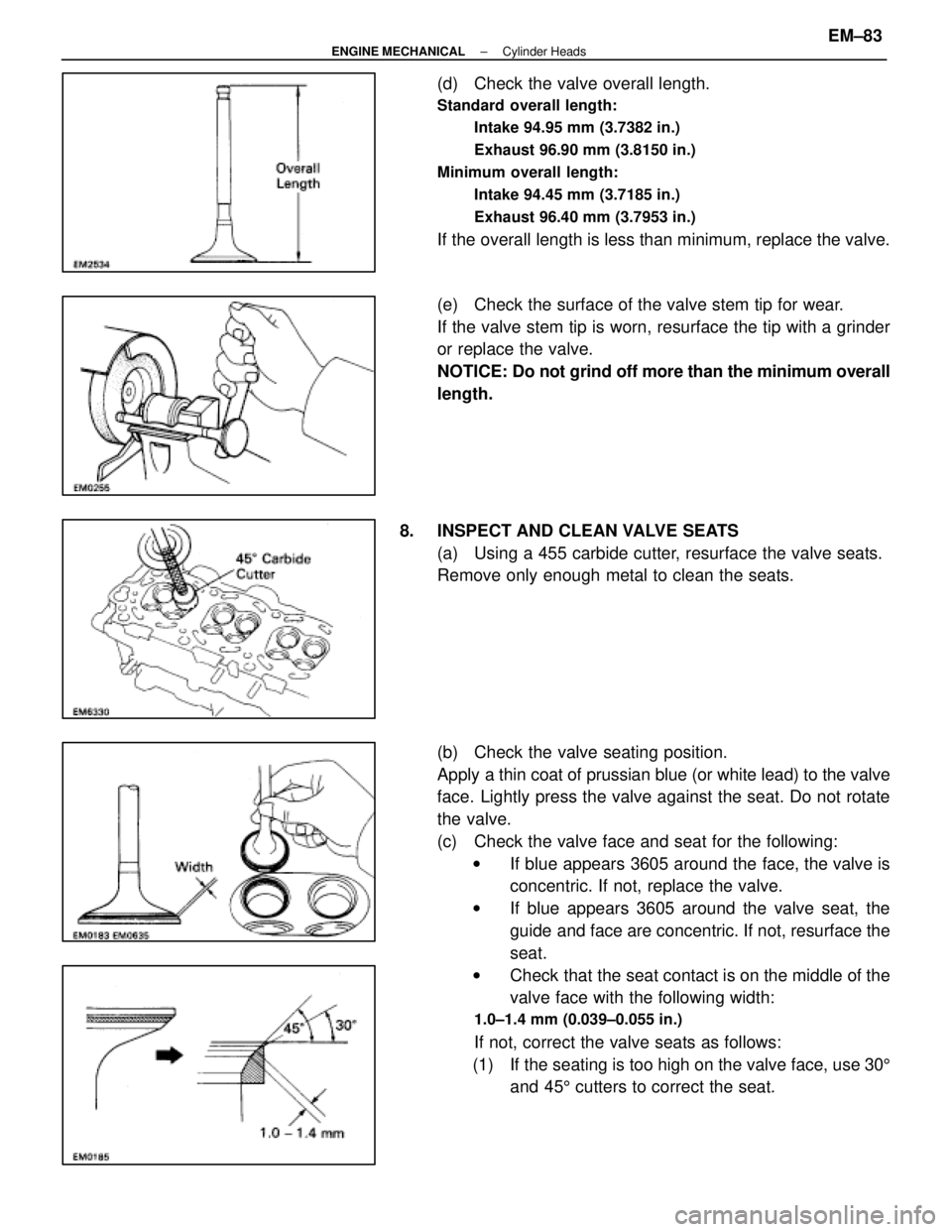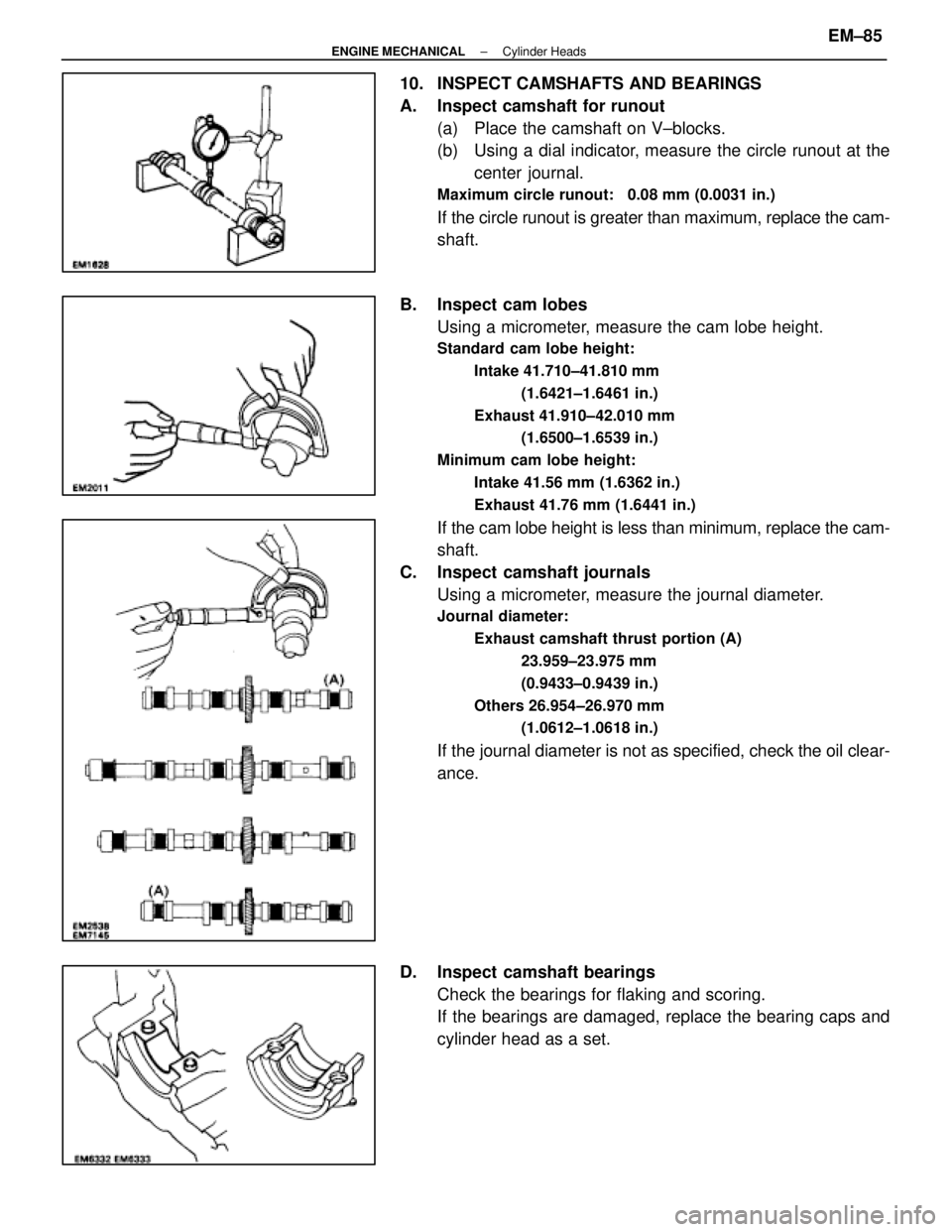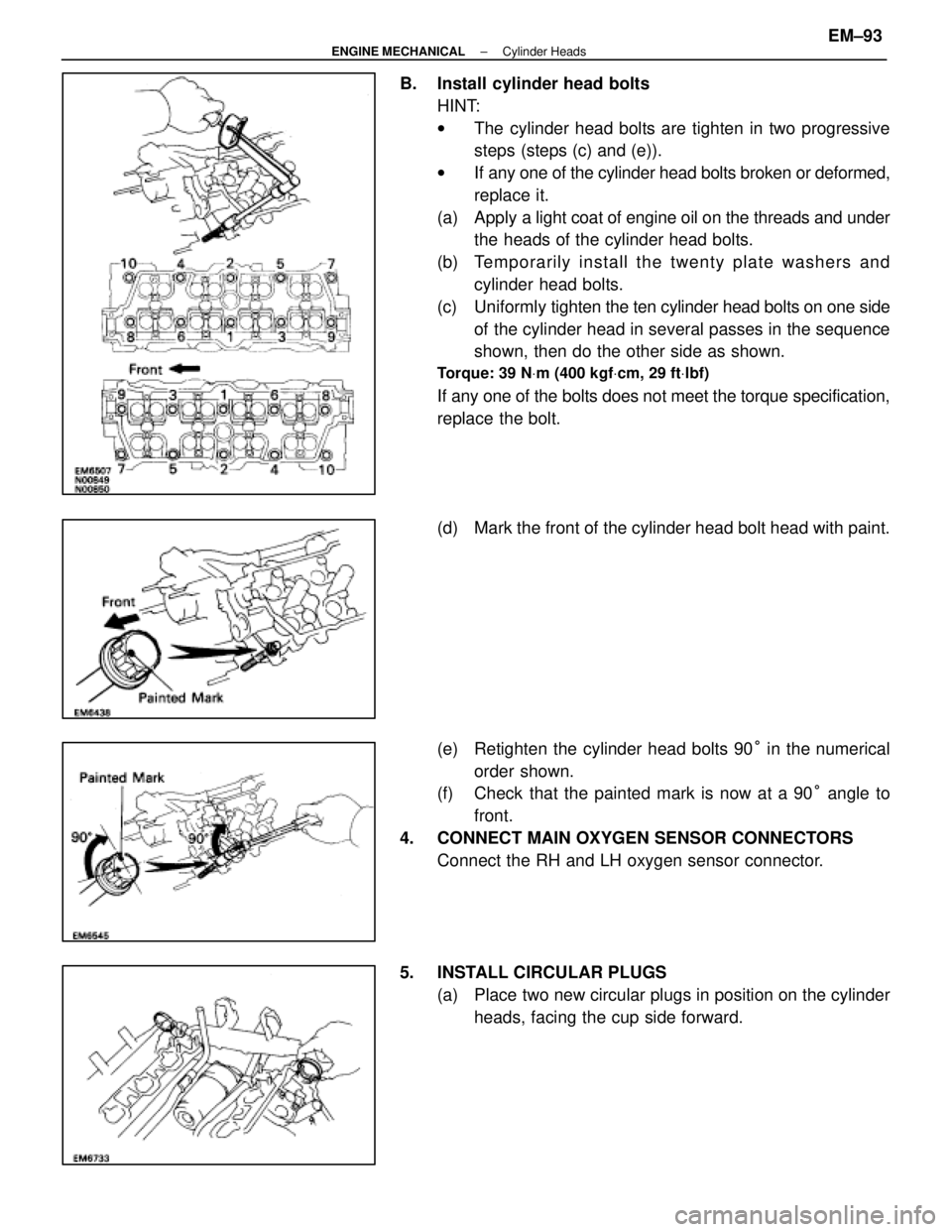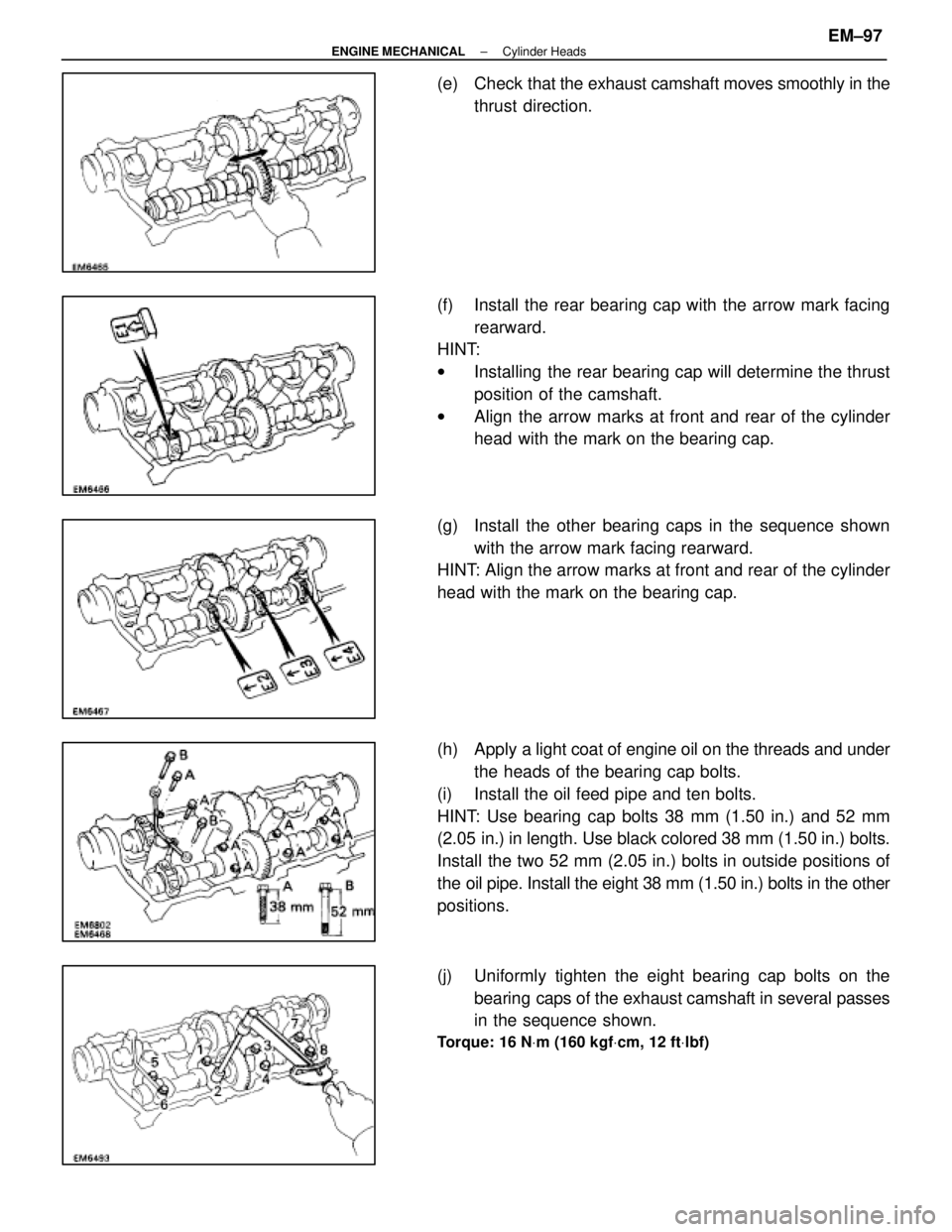Page 2266 of 4087
(c) Remove the two bolts and gaskets, and disconnect theEGR pipe from the air intake chamber.
(d) Remove the four mounting bolts, eight mounting nuts and following parts:
(1) VSV for fuel pressure control system
(2) (Exc. USA Spec.)
VSV for EGR system
(3) A/T throttle cable bracket
(e) Disconnect the check (ºDIAGNOSISº) connector from
the intake chamber.
(f) Remove the air intake chamber and four gaskets.
(g) Remove the three bolts, the cold start injector, tube, lead
wire assembly and gasket.
21. DISCONNECT HEATER WATER HOSES Disconnect the following hoses:(1) Water hose from water by±pass pipe
(2) Water hose from rear water by±pass joint
22. DISCONNECT FUEL INLET HOSE FROM LH DELIVERY PIPE
Remove the pulsation damper and two gaskets, and discon-
nect the inlet hose.
23. D I S C O N N E C T F U E L R E T U R N H O S E F R O M F U E L RETURN PIPE
EM±66
±
ENGINE MECHANICAL Cylinder Heads
WhereEverybodyKnowsYourName
Page 2279 of 4087
D. Clean cylinder headsUsing a soft brush and solvent, thoroughly clean the cylinder
heads.
3. INSPECT CYLINDER HEADS
A. Inspect for flatness Using a precision straight edge and feeler gauge, measure
the surfaces contacting the cylinder block and manifolds for
warpage.
Maximum warpage: 0.10 mm (0.0039 in.)
If warpage is greater than maximum, replace the cylinder
head.
B. Inspect for cracks Using a dye penetrant, check the combustion chamber, in-
take ports, exhaust ports and cylinder block surface for
cracks.
If cracked, replace the cylinder head.
4. CLEAN VALVES (a) Using a gasket scraper, chip any carbon from the valvehead.
(b) Using a wire brush, thoroughly clean the valve.
±
ENGINE MECHANICAL Cylinder HeadsEM±79
WhereEverybodyKnowsYourName
Page 2282 of 4087
(g) Using SST and a hammer, tap in a new guide bushinguntil the snap ring makes contact with the cylinder head.
SST 09201±70010
HINT: Different the bushings are used for the intake and ex-
haust.
(h) Using a sharp 6 mm reamer, ream the guide bushing to obtain the standard specified clearance (See page
EM±80 ) between the guide bushing and valve stem.
7. INSPECT AND GRIND VALVES (a) Grind the valve enough to remove pits and carbon.
(b) Check that the valve is ground to the correct valve faceangle.
Valve face angle: 44.5 5
(c) Check the valve head margin thickness.
Standard margin thickness: 1.0 mm (0.039 in.)
Minimum margin thickness: 0.5 mm (0.020 in.)
If the margin thickness is less than minimum, replace the
valve.
EM±82
±
ENGINE MECHANICAL Cylinder Heads
WhereEverybodyKnowsYourName
Page 2283 of 4087

(d) Check the valve overall length.
Standard overall length:Intake 94.95 mm (3.7382 in.)
Exhaust 96.90 mm (3.8150 in.)
Minimum overall length: Intake 94.45 mm (3.7185 in.)
Exhaust 96.40 mm (3.7953 in.)
If the overall length is less than minimum, replace the valve.
(e) Check the surface of the valve stem tip for wear.
If the valve stem tip is worn, resurface the tip with a grinder
or replace the valve.
NOTICE: Do not grind off more than the minimum overall
length.
8. INSPECT AND CLEAN VALVE SEATS (a) Using a 455 carbide cutter, resurface the valve seats.
Remove only enough metal to clean the seats.
(b) Check the valve seating position.
Apply a thin coat of prussian blue (or white lead) to the valve
face. Lightly press the valve against the seat. Do not rotate
the valve.
(c) Check the valve face and seat for the following:w If blue appears 3605 around the face, the valve is
concentric. If not, replace the valve.
w If blue appears 3605 around the valve seat, the
guide and face are concentric. If not, resurface the
seat.
w Check that the seat contact is on the middle of the
valve face with the following width:
1.0±1.4 mm (0.039±0.055 in.)
If not, correct the valve seats as follows:
(1) If the seating is too high on the valve face, use 30 5
and 45 5 cutters to correct the seat.
±
ENGINE MECHANICAL Cylinder HeadsEM±83
WhereEverybodyKnowsYourName
Page 2285 of 4087

10. INSPECT CAMSHAFTS AND BEARINGS
A. Inspect camshaft for runout(a) Place the camshaft on V±blocks.
(b) Using a dial indicator, measure the circle runout at thecenter journal.
Maximum circle runout: 0.08 mm (0.0031 in.)
If the circle runout is greater than maximum, replace the cam-
shaft.
B. Inspect cam lobes Using a micrometer, measure the cam lobe height.
Standard cam lobe height:
Intake 41.710±41.810 mm (1.6421±1.6461 in.)
Exhaust 41.910±42.010 mm (1.6500±1.6539 in.)
Minimum cam lobe height: Intake 41.56 mm (1.6362 in.)
Exhaust 41.76 mm (1.6441 in.)
If the cam lobe height is less than minimum, replace the cam-
shaft.
C. Inspect camshaft journals Using a micrometer, measure the journal diameter.
Journal diameter:
Exhaust camshaft thrust portion (A) 23.959±23.975 mm
(0.9433±0.9439 in.)
Others 26.954±26.970 mm (1.0612±1.0618 in.)
If the journal diameter is not as specified, check the oil clear-
ance.
D. Inspect camshaft bearings Check the bearings for flaking and scoring.
If the bearings are damaged, replace the bearing caps and
cylinder head as a set.
±
ENGINE MECHANICAL Cylinder HeadsEM±85
WhereEverybodyKnowsYourName
Page 2290 of 4087
2. INSTALL VALVES(a) Using SST, push in a new oil seal.
SST 09201±41020
(b) Install the following parts:(1) Valve
(2) Spring seat
(3) Valve spring
(4) Spring retainer
(c) Using SST, compress the valve spring and place the two
keepers around the valve stem.
SST 09202±70010
(d) Using a plastic±faced hammer, lightly tap the valve stem
tip to assure proper fit.
3. INSTALL VALVE LIFTERS AND SHIMS Check the valve lifter rotates smoothly by hand.
EM±90
±
ENGINE MECHANICAL Cylinder Heads
WhereEverybodyKnowsYourName
Page 2293 of 4087

B. Install cylinder head boltsHINT:
wThe cylinder head bolts are tighten in two progressive
steps (steps (c) and (e)).
w If any one of the cylinder head bolts broken or deformed,
replace it.
(a) Apply a light coat of engine oil on the threads and under
the heads of the cylinder head bolts.
(b) Te mp o ra rily in sta ll th e twe n ty pla te wa sh e rs an d cylinder head bolts.
(c) Uniformly tighten the ten cylinder head bolts on one side
of the cylinder head in several passes in the sequence
shown, then do the other side as shown.
Torque: 39 N Vm (400 kgf Vcm, 29 ft Vlbf)
If any one of the bolts does not meet the torque specification,
replace the bolt.
(d) Mark the front of the cylinder head bolt head with paint.
(e) Retighten the cylinder head bolts 90 ° in the numerical
order shown.
(f) Check that the painted mark is now at a 90 ° angle to
front.
4. CONNECT MAIN OXYGEN SENSOR CONNECTORS Connect the RH and LH oxygen sensor connector.
5. INSTALL CIRCULAR PLUGS (a) Place two new circular plugs in position on the cylinderheads, facing the cup side forward.
±
ENGINE MECHANICAL Cylinder HeadsEM±93
WhereEverybodyKnowsYourName
Page 2297 of 4087

(e) Check that the exhaust camshaft moves smoothly in the
thrust direction.
(f) Install the rear bearing cap with the arrow mark facing rearward.
HINT:
w Installing the rear bearing cap will determine the thrust
position of the camshaft.
w Align the arrow marks at front and rear of the cylinder
head with the mark on the bearing cap.
(g) Install the other bearing caps in the sequence shown with the arrow mark facing rearward.
HINT: Align the arrow marks at front and rear of the cylinder
head with the mark on the bearing cap.
(h) Apply a light coat of engine oil on the threads and under
the heads of the bearing cap bolts.
(i) Install the oil feed pipe and ten bolts.
HINT: Use bearing cap bolts 38 mm (1.50 in.) and 52 mm
(2.05 in.) in length. Use black colored 38 mm (1.50 in.) bolts.
Install the two 52 mm (2.05 in.) bolts in outside positions of
the oil pipe. Install the eight 38 mm (1.50 in.) bolts in the other
positions.
(j) Uniformly tighten the eight bearing cap bolts on the bearing caps of the exhaust camshaft in several passes
in the sequence shown.
Torque: 16 N Vm (160 kgf Vcm, 12 ft Vlbf)
±
ENGINE MECHANICAL Cylinder HeadsEM±97
WhereEverybodyKnowsYourName